Natural History Museum, London
C1 | |
| Website | www |
|---|---|
The Natural History Museum in
The museum is home to life and earth science specimens comprising some 80 million items within five main collections:
Although commonly referred to as the Natural History Museum, it was officially known as British Museum (Natural History) until 1992, despite legal separation from the British Museum itself in 1963. Originating from collections within the British Museum, the landmark Alfred Waterhouse building was built and opened by 1881 and later incorporated the Geological Museum. The Darwin Centre is a more recent addition, partly designed as a modern facility for storing the valuable collections.
Like other publicly funded national museums in the United Kingdom, the Natural History Museum does not charge an admission fee.[2] The museum is an exempt charity and a non-departmental public body sponsored by the Department for Culture, Media and Sport.[3][4] The Princess of Wales is a patron of the museum.[5] There are approximately 850 staff at the museum. The two largest strategic groups are the Public Engagement Group and Science Group.[6]
History
Early history
This section needs additional citations for verification. (April 2024) |

(Link to current floor plans).
The foundation of the collection was that of the Ulster doctor Sir Hans Sloane (1660–1753), who allowed his significant collections to be purchased by the British Government at a price well below their market value at the time. This purchase was funded by a lottery. Sloane's collection, which included dried plants, and animal and human skeletons, was initially housed in Montagu House, Bloomsbury, in 1756, which was the home of the British Museum.
Most of the Sloane collection had disappeared by the early decades of the nineteenth century. Dr George Shaw (Keeper of Natural History 1806–1813) sold many specimens to the Royal College of Surgeons and had periodic cremations of material in the grounds of the museum. His successors also applied to the trustees for permission to destroy decayed specimens.[7] In 1833, the Annual Report states that, of the 5,500 insects listed in the Sloane catalogue, none remained. The inability of the natural history departments to conserve its specimens became notorious: the Treasury refused to entrust it with specimens collected at the government's expense. Appointments of staff were bedevilled by gentlemanly favouritism; in 1862 a nephew of the mistress of a Trustee was appointed Entomological Assistant despite not knowing the difference between a butterfly and a moth.[8][9][verification needed]
The Principal Librarian at the time was
Many of these faults were corrected by the
Planning and architecture of new building

Owen saw that the natural history departments needed more space, and that implied a separate building as the British Museum site was limited. Land in South Kensington was purchased, and in 1864 a competition was held to design the new museum. The winning entry was submitted by the civil engineer Captain Francis Fowke, who died shortly afterwards. The scheme was taken over by Alfred Waterhouse who substantially revised the agreed plans, and designed the façades in his own idiosyncratic Romanesque style which was inspired by his frequent visits to the Continent.[12] The original plans included wings on either side of the main building, but these plans were soon abandoned for budgetary reasons. The space these would have occupied are now taken by the Earth Galleries and Darwin Centre.
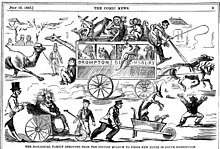
Work began in 1873 and was completed in 1880. The new museum opened in 1881, although the move from the old museum was not fully completed until 1883.
Both the interiors and exteriors of the Waterhouse building make extensive use of architectural terracotta tiles to resist the sooty atmosphere of Victorian London, manufactured by the Tamworth-based company of Gibbs and Canning. The tiles and bricks feature many relief sculptures of flora and fauna, with living and extinct species featured within the west and east wings respectively. This explicit separation was at the request of Owen, and has been seen as a statement of his contemporary rebuttal of Darwin's attempt to link present species with past through the theory of natural selection.[13] Though Waterhouse slipped in a few anomalies, such as bats amongst the extinct animals and a fossil ammonite with the living species. The sculptures were produced from clay models by a French sculptor based in London, M Dujardin, working to drawings prepared by the architect.[14]
The central axis of the museum is aligned with the tower of Imperial College London (formerly the Imperial Institute) and the Royal Albert Hall and Albert Memorial further north. These all form part of the complex known colloquially as Albertopolis.
Separation from the British Museum
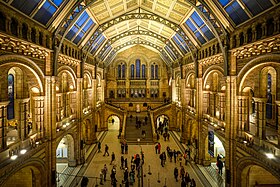
Even after the opening, the Natural History Museum legally remained a department of the British Museum with the formal name British Museum (Natural History), usually abbreviated in the
Geological Museum
In 1985, the museum merged with the adjacent Geological Museum of the British Geological Survey,[15][16] which had long competed for the limited space available in the area. The Geological Museum became world-famous for exhibitions including an active volcano model and an earthquake machine (designed by James Gardner), and housed the world's first computer-enhanced exhibition (Treasures of the Earth). The museum's galleries were completely rebuilt and relaunched in 1996 as The Earth Galleries, with the other exhibitions in the Waterhouse building retitled The Life Galleries. The Natural History Museum's own mineralogy displays remain largely unchanged as an example of the 19th-century display techniques of the Waterhouse building.
The central atrium design by Neal Potter overcame visitors' reluctance to visit the upper galleries by "pulling" them through a model of the Earth made up of random plates on an escalator. The new design covered the walls in recycled slate and sandblasted the major stars and planets onto the wall. The museum's 'star' geological exhibits are displayed within the walls. Six iconic figures were the backdrop to discussing how previous generations have viewed Earth. These were later removed to make place for a Stegosaurus skeleton that was put on display in late 2015.
The Darwin Centre
The Darwin Centre (named after Charles Darwin) was designed as a new home for the museum's collection of tens of millions of preserved specimens, as well as new work spaces for the museum's scientific staff and new educational visitor experiences. Built in two distinct phases, with two new buildings adjacent to the main Waterhouse building, it is the most significant new development project in the museum's history.
Phase one of the Darwin Centre opened to the public in 2002, and it houses the
Arguably the most famous creature in the centre is the 8.62-metre-long giant squid, affectionately named Archie.[19]
The Attenborough Studio
As part of the museum's remit to communicate science education and conservation work, a new multimedia studio forms an important part of Darwin Centre Phase 2. In collaboration with the
Major specimens and exhibits
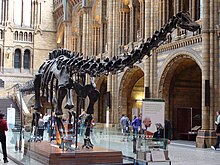
One of the most famous and certainly most prominent of the exhibits—nicknamed "
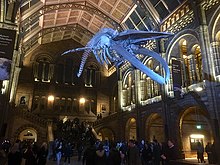
The blue whale skeleton, Hope, that has replaced Dippy, is another prominent display in the museum. The display of the skeleton, some 82 feet (25 m) long and weighing 4.5 tonnes, was only made possible in 1934 with the building of the New Whale Hall (now the Mammals (blue whale model) gallery). The whale had been in storage for 42 years since its stranding on sandbanks at the mouth of
The Darwin Centre is host to
The museum holds the remains and bones of the "River Thames whale", a northern bottlenose whale that lost its way on 20 January 2006 and swam into the Thames. Although primarily used for research purposes, and held at the museum's storage site at Wandsworth.
Dinocochlea, one of the longer-standing mysteries of paleontology (originally thought to be a giant gastropod shell, then a coprolite, and now a concretion of a worm's tunnel), has been part of the collection since its discovery in 1921.
The museum keeps a wildlife garden on its west lawn, on which a potentially new species of insect resembling Arocatus roeselii was discovered in 2007.[25]
Galleries
The museum is divided into four sets of galleries, or zones, each colour coded to follow a broad theme.
Red Zone

This is the zone that can be entered from Exhibition Road, on the East side of the building. It is a gallery themed around the changing history of the Earth.
Earth's Treasury shows specimens of rocks, minerals and gemstones behind glass in a dimly lit gallery. Lasting Impressions is a small gallery containing specimens of rocks, plants and minerals, of which most can be touched.
- Earth Hall (Stegosaurus skeleton)
- Human Evolution
- Earth's Treasury
- Lasting Impressions
- Restless Surface
- From the Beginning
- Volcanoes and Earthquakes
- The Waterhouse Gallery (temporary exhibition space)
Green zone
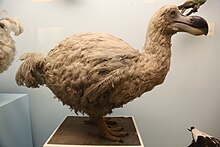
This zone is accessed from the Cromwell Road entrance via the Hintze Hall and follows the theme of the evolution of the planet.
- Birds
- Creepy Crawlies
- Fossil Way (marine reptiles, a giant sloth, and the Swindon stegosaur Dacentrurus)
- Hintze Hall (formerly the Central Hall, with blue whale skeleton and giant sequoia)
- Minerals
- The Vault
- Fossils from the UK
- Anning Rooms (exclusive space for members and patrons of the museum)
- Investigate
- East Pavilion (space for changing Wildlife Photographer of the Year exhibition)
Blue zone
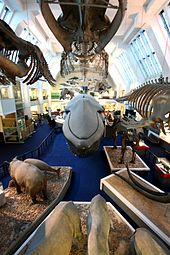
To the left of the Hintze Hall, this zone explores the diversity of life on the planet.
- Dinosaurs
- Fish, Amphibians and Reptiles
- Human Biology
- Images of Nature
- The Jerwood Gallery (temporary exhibition space)
- Marine Invertebrates
- Mammals
- Mammals Hall (blue whale model)
- Treasures in the Cadogan Gallery
Orange zone
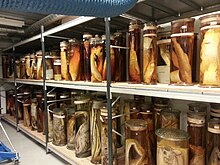
Enables the public to see science at work and also provides spaces for relaxation and contemplation. Accessible from Queens Gate.
- Wildlife Garden
- Darwin Centre
- Zoology Spirit Building
Highlights of the collection
- Otumpa iron meteorite weighing 635 kg (1,400 lb), found in 1783 in Campo del Cielo, Argentina
- Fragments of the Nakhla meteorite from Egypt, the first meteorite to suggest signs of aqueous processes on Mars
- Latrobe nugget, one of the largest known clusters of cubic gold crystals
- Apollo 16 Moon rock sample collected in 1972
- Ostro Stone, flawless blue topaz gemstone weighing 9,381 carats, about 2 kg (4.4 lb), the largest of its kind in the world
- Aurora Pyramid of Hope, a collection of 296 natural diamonds in a wide variety of colours
- First ichthyosaur material discovered by Mary Anning
- First complete skeleton of a plesiosaur ever discovered
- The plesiosaur Attenborosaurus named after David Attenborough
- Cast of a huge skeleton of Rhomaleosaurus
- First Iguanodon teeth ever discovered
- Near complete skeleton of Mantellisaurus
- The most intact Stegosaurus fossil skeleton ever discovered (nicknamed Sophie)
- Large skull of a Triceratops
- Skeleton of Baryonyx
- Full-sized animatronic model of a Tyrannosaurus rex
- First specimen of Archaeopteryx ever discovered, one of only 12 found and generally accepted by palaeontologists to be the oldest known bird
- Rare dodo skeleton, reconstructed from bones over 1,000 years old
- Only surviving specimen of the Great Auk from the British Isles, collected in 1813 from Papa Westrayin the Orkney Islands
- A complete skeleton of an American mastodon
- cranium now considered part of a Homo heidelbergensis, discovered in the mine of Broken Hill or Kabwe in Zambia
- Gibraltar 1 and Gibraltar 2, two Neanderthal skulls found at Forbes' Quarry in Gibraltar
- Cross-section of 1,300-year-old giant sequoia, at the museum since 1893
- Rare copy of The Birds of America by John James Audubon, containing illustrations of a wide variety of birds from the United States
- Rare first edition of Charles Darwin's On the Origin of Species
Education and research

The museum runs a series of educational and public engagement programmes. These include for example a highly praised "How Science Works" hands on workshop for school students demonstrating the use of microfossils in geological research. The museum also played a major role in securing designation of the Jurassic Coast of Devon and Dorset as a UNESCO World Heritage Site and has subsequently been a lead partner in the Lyme Regis Fossil Festivals.
In 2005, the museum launched a project to develop notable gallery characters to patrol display cases, including 'facsimiles' of Carl Linnaeus, Mary Anning, Dorothea Bate and William Smith. They tell stories and anecdotes of their lives and discoveries and aim to surprise visitors.[26]
In 2010, a six-part
Since May 2001, the Natural History Museum admission has been free for some events and permanent exhibitions. However, there are certain temporary exhibits and shows that require a fee.
The Natural History museum combines the museum's life and earth science collections with specialist expertise in "taxonomy, systematics, biodiversity, natural resources, planetary science, evolution and informatics" to tackle scientific questions.[28] In 2011, the museum led the setting up of an
Access
| Service | Station/Stop | Lines/Routes served |
|---|---|---|
| London Buses |
Kensington Museums |
360 |
| Victoria & Albert Museum |
C1
| |
| London Underground |
South Kensington |
The closest London Underground station is South Kensington — there is a tunnel from the station that emerges close to the entrances of all three museums. Admission to the museum is free, though there are donation boxes in the foyer.
A connecting bridge between the Natural History and Science museums closed to the public in the late 1990s.
In popular culture
The museum plays an important role in the 1975 London-based
The museum features as a base for Prodigium, a secret society which studies and fights monsters, first appearing on The Mummy.[33][34]
In the 2014 film Paddington, Millicent Clyde is a devious and treacherous taxidermist at the museum. She kidnaps Paddington, intending to kill and stuff him, but is thwarted by the Brown family after scenes involving chases inside and on the roof of the building.[33][35]
The museum was prominently featured in the Sky One 2014 documentary David Attenborough's Natural History Museum Alive where several extinct creatures exhibited at the museum including Dippy the Diplodocus were brought to life using CGI.
The museum features prominently in the level Lud's Gate from Tomb Raider III, with Core Design launching the game with Jonathan Ross at the museum on 15 October 1998.[36]
Andy Day's CBeebies shows, Andy's Dinosaur Adventures and Andy's Prehistoric Adventures are filmed in the Natural History Museum.[33]
The museum was site of the first Pit Stop on The Amazing Race 33.[37]
The Museum is featured in the fifth episode of the Apple TV+ period drama The Essex Serpent.[38]
Natural History Museum at Tring
The NHM also has an outpost in
Move of collections to Harwell and Shinfield
There has been some discussion of plans to move major parts of the collections to sites in Harwell (which was abandoned) and then to Shinfield, Berkshire. These plans have been heavily criticized, together with the overall departure of the strategic direction of the museum.[39]
See also
- James John Joicey
- Keeper of Entomology, Natural History Museum
- Sophie the Stegosaurus
- Category:Employees of the Natural History Museum, London
References
- ^ "British Museum is the most-visited UK attraction again". BBC News. 18 March 2024. Retrieved 18 March 2024.
- ^ "Natural History Museum scraps £9 fee". www.telegraph.co.uk. 24 May 2001. Archived from the original on 11 January 2022.
- ^ "Museum governance". The Natural History Museum. Retrieved 14 March 2010.
- ^ "Natural History Museum". gov.uk. Retrieved 4 April 2023.
- ^ Harrison, Lily; Caldwell, Lindsey (22 April 2013). "Duchess Kate to become patron of three new charities". Today News.
- ^ "Our vision". nhm.ac.uk.
- ISBN 9780903874359.
- ISBN 9780712906180.
- ISBN 9780950727608.
- ISBN 9780224014489.
- ISBN 9780385408189.
- ^ "Interior of the NHM". Royal Institute of British Architects. Archived from the original on 19 January 2012. Retrieved 14 December 2010.
- ^ "Decoration". nhm.ac.uk. Archived from the original on 8 June 2011.
- ISBN 9780565094836.
- ^ "Written Answer: Geological and British Museums HC Deb 31 July 1984". Hansard. 65: c185W. 1984.
- ^ Hackett, Dennis (1999). Our corporate history. Key events affecting the British Geological Survey, 1967–1998 (Technical Report, WQ/99/1 ed.). British Geological Survey.
- ^ "Museum 'cocoon' prepares to open". BBC News. 2 September 2008. Retrieved 20 January 2009.
- ^ a b "Behind-the-Scenes Tour: Spirit Collection | Natural History Museum". www.nhm.ac.uk. Retrieved 20 October 2017.
- ^ "Giant squid goes on display". nhm.ac.uk. Archived from the original on 20 April 2006. Retrieved 14 March 2006.
- ^ "Coldplay prove they're not fossils as they play Natural History Museum gig". BBC. Retrieved 26 November 2019.
- ^ McVeigh, Tracy (1 January 2017). "Dippy's last days: diplodocus leaves London after 112 years for farewell UK tour". The Observer.
- ^ a b Fuller, George (4 January 2017). "Dippy the Diplodocus bids farewell to his public at the Natural History Museum". The Daily Telegraph. Archived from the original on 11 January 2022.
- ^ "Dippy on Tour: A Natural History Adventure". Natural History Museum.
- ^ "Dippy and the Whale". DocuWiki. 15 July 2017.
- ^ "Mystery Insect Bugs Experts". Sky news. 15 July 2008.
- ^ Review by Miles Russell of Discovering Dorothea: the Life of the Pioneering Fossil-Hunter Dorothea Bate by Karolyn Shindler at ucl.ac.uk (accessed 23 November 2007)
- ^ "Museum of Life". The Natural History Museum. 2010. Archived from the original on 30 August 2010. Retrieved 5 January 2011.
- ^ Research and curation, Museum of Natural History, n.d., retrieved 22 December 2013
- ^ Bumblebee Specialist Group, London, UK: Natural History Museum, retrieved 23 December 2013
- ^ 2011 Update (PDF), IUCN, archived from the original (PDF) on 3 December 2012, retrieved 7 October 2012
- .
- ^ Museum entrances, Natural History Museum.
- ^ a b c d "The Museum at the movies: 13 chances to see us on screen". Natural History Museum. Retrieved 8 December 2021.
- ^ Clarke, Donald. "Make it stop, Mummy! Tom Cruise movie a lumbering waste of time". The Irish Times. Retrieved 8 December 2021.
- ^ O'Connor, Joanne (5 December 2014). "On location: Paddington". Financial Times. Archived from the original on 10 December 2022. Retrieved 1 January 2015.
- ^ "Tomb Raider 3 Events". Retrieved 12 March 2022.
- ^ Caruso, Nick (5 January 2022). "The Amazing Race Season 33 Premiere Recap: Has Anyone Seen (a) Bobby? — Plus, Who Was Eliminated First?". TVLine. Retrieved 5 January 2022.
- ^ "The Making of The Essex Serpent". 21 October 2022. Retrieved 19 November 2023.
- ISSN 2703-3090.
Bibliography
- Dr ISBN 0-906795-04-4. (Includes illustrations by Lister's wife and daughter).
- The Travelling ISBN 0-7099-1658-2.
- Dry storeroom no 1: The Secret Life of the Natural History Museum (2009) by Richard Fortey. HarperPress (UK). ISBN 978-0307275523.
- Nature's Cathedral: A celebration of the Natural History Museum building (2020) by John Thackray, Bob Press and Sandra Knapp. Natural History Museum. ISBN 978 0 565 09483 6
External links
 ButMoth ID (P3060) (see uses)
ButMoth ID (P3060) (see uses)
- Official website

- Picture Library of the Natural History Museum
- The Natural History Museum on Google Cultural Institute
- Architectural history and description from the Survey of London
- Architecture and history of the NHM from the Royal Institute of British Architects
- Maps of grid reference TQ267792
- Nature News article on proposed cuts, June 2010
